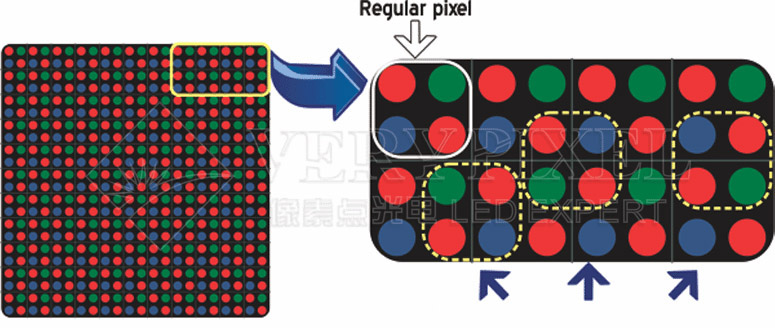|
Nowadays, many companies that sell large LED display screens, especially in South China, are trying to edge their products on the higher competitive level, tended to claim that their LED signs use an advanced technology of “virtual pixel”. What is ‘VIRTUAL PIXEL’? Why we should put “” or ‘’on it?
Unfortunately, suppliers do not always provide real and detailed information on the use and functions of “virtual pixel”. They assure customers that LED screen models with “virtual pixel” are much better resolution than corresponding models with real pixel. Are there any ‘smart’ marketing tricks behind?
While, let’s study virtual pixel, and reveal you the big truth of ‘VIRTUAL PIXEL’. First we have to try to analyze the situation and how to define, where and when it makes sense to use technology of “virtual pixel” and is it true that “virtual pixel” doubles the real resolution.
“Virtual pixel” of video screen
A video screen is composed of light sources positioning as a square 2R1G1B. Each light source radiates light of a certain visible wavelength (or narrow range) or in laymen terms produces colored light. Verypixel typical virtual picture showed as follows:

Figure 1
When image is displayed on an LED display screen in a “normal” mode (Fig. 1) each pixel of the original image has a certain corresponding pixel on the LED display board. In a “virtual pixel” design, each pixel of the initial image corresponds not to a screen pixel but to a light source. Virtual pixels are in a class of their own. Every Virtual pixel contains 2 Red lamps, 1 Blue LED and 1 Green LED. Each LED is spaced out evenly to provide an even higher degree of clarity.
Usually, if your display has less than 50,000 pixels totally, we highly suggest you use virtual pixel. Real LED pixel is the physical LED pixel; virtual LED pixel is theoretically 4 times as real LED pixel. While it is just theoretically, actually, the real effect of the virtual pixel is not really 4 times better. It is only a much “better”, but not really can be 4 times better. When you LED display system is more than 512*320pixels, actually you do not need to use virtual pixel if you plan to use the whole LED display for one advertising contents, but if you plan to divide a big LED screen into small parts or small sections for many advertising contents, the virtual pixel is still very necessary and useful for you to achieve much better effect.
Thus, in a “virtual pixel” mode one screen pixel contains information on four pixels of the initial image. The image projected on a screen seems having doubled resolution in each dimension compared to a “real pixel” resolution of a LED display sign. This usually leads people to conclude that screen resolution also 4 times up, which is not exactly true. The fact is one screen pixel cannot hold and show all information from the initial four pixels. Part of the information gets lost.
Suppose that the initial image (with resolution twice higher than “physical” screen pixel resolution) looks as a horizontal blue line (one pixel thick) on a black background. If the line appears on an even row of pixels, the video screen will display a corresponding blue line. But if the line shifts to an odd row of pixels, it will simply disappear: the video screen will remain black. In other words, smaller details and sharp color borders shall be displayed with distortions, or the virtual display is showing defectively, which are not evident in the initial image.
Are there any advantages of “virtual pixel” technology? Yes.
Virtual pixels are in a class of their own. Every Virtual pixel contains 2 Red lamps, 1 Blue LED and 1 Green LED. Each LED is spaced out evenly to provide an even higher degree of clarity. Virtual pixel provides more shades of colors due to the many different levels of intensity combinations. Virtual Modules provide brighter pictures and videos. Virtual pixels are perfect for outdoor use in any condition. They provide great visibility during day and night. Only in some cases the overall displayed quality may be improved though image details will be distorted. This technology works better with smooth color gradients or on patchy images when color distortions are not evident. In a way, we can talk about doubling screen resolution only for black color because all light elements with black color look the same, i.e. they remain unlighted.
Does this technology have disadvantage? YES, absolutely. Every coin has two sides. The main disadvantage is the original image pixels are displayed in a distortion, which may cause some kind of ‘BLURRING’. While our eyes are certainly does not have time to catch the distortion. So actually, ‘VIRTUAL PIXEL’ is lying to your eyes. While, sometimes who cares?
By Verypixel optoelectronic co., ltd.
|